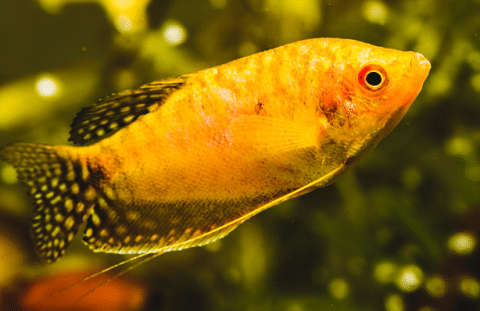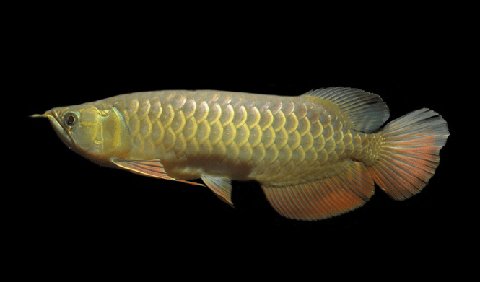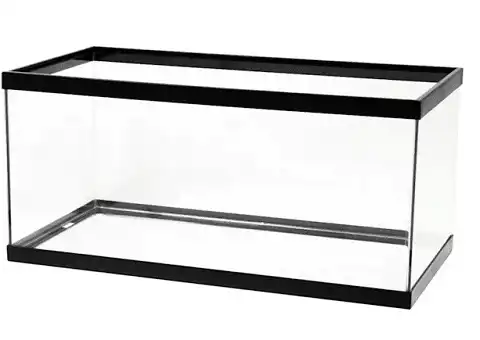Thank you for visiting! By the way… any links on this page that lead to products on Amazon and other stores/partners are affiliate links Aquarium Store Depot earns a commission if you make a purchase.
The Gold Gourami is a fish that appears to be an easy to care for and peaceful fish. However, these beautiful creatures have a mean streak that gets quite large and requires research to keep successfully. This post will discuss their unique characteristics as well as provide advice on proper care practices. Join us on our underwater voyage!
Key Takeaways
- Gold Gouramis are a popular aquarium choice due to their striking appearance and hardiness.
- Creating the perfect home for your Gold Gouramis requires understanding their specific requirements, such as tank size, water parameters & filtration, substrate/plants/decorations & diet
- These fish are semi-aggressive and grow to 6 inches in length
- They need lots of space to curb aggression in order to keep in community tanks with other fish
Species Overview
| Scientific Name | Trichopodus trichopterus |
| Common Names | Gold Gourami, Three Spot Gourami |
| Family | Osphronemidae |
| Origin | Southeast Asia |
| Diet | Omnivore |
| Care Level | Moderate |
| Activity | Slow to Moderate |
| Lifespan | 4 to 6 years |
| Temperament | Semi-Aggressive |
| Tank Level | Mid to Top |
| Minimum Tank Size | 40 gallons (3 foot length minimum) |
| Water Temperature Range | 72°-82°F |
| Water Hardness | 4 – 18 dKH |
| pH Range | 6.0 – 7.5 |
| Filtration/Water Flow | Moderate |
| Water Type | Freshwater |
| Breeding | Egg Layers in Bubble Nests |
| Difficulty to Breed | Moderate |
| Compatibility | Community fish – with the right fish |
| OK, for Planted Tanks? | Yes |
Species Introduction
Gold Gouramis (Trichopodus trichopterus) are a favorite pick among aquarists for their vibrant coloring and resilience. These freshwater fish, native to Southeast Asia, showcase an attractive golden color combined with stripes near the back of them. The presence of its Labyrinth organ offers them adaptability in harsh environments as it allows these creatures to breathe air from outside sources apart from water alone.
Their looks and their adaptability make them great showcase fish, and with the right tankmates they can be housed in a community thank.
Origin And Habit
Gold Gouramis, a type of labyrinth fish hailing from Southeast Asia and Indonesia with their natural habitat consisting mostly of vegetation in slow-moving waters. Their diets predominantly comprised crustaceans, insect larvae, and zooplankton, which dictate what kind of foods they require to thrive as captives. It is important that one familiarize oneself with the conditions necessary to replicate Gold Gourami’s original environment so you can keep them under low stress conditions that allow them to thrive.
Appearance (Physical Characteristics)
Gold Gouramis, a gourami species of fish, display an attractive golden hue that transitions into stripes near the rear. This is especially visible in male Gold Gouramis. They have wide fins and flat bodies with beautiful orangish-yellow pigmentations. An interesting aspect about them is their labyrinth organ, which allows for direct air breathing from water surfaces, something not commonly found among other fish types (though standard with Betta Fish – a close causing of the gouramis)!

Males and females are easy to differentiate thanks to sexual dimorphism1: Males possess pointed dorsal fin while females feature rounder fins in comparison. Thus, it makes mating selection much simpler if one chooses to add variety to aquariums containing these creatures. There is also a blue color variation of this fish called the Blue Gourami with a similar temperament.
These fish are sometimes classified incorrectly. Trichopodus trichopterus is another species that is known as the three spot gourami. These fish are differentiated by the shorter dorsal fin base on the Trichopodus versus the Trichogaster gouramis.
Average Size
Gold Gouramis will grow up to 6 inches in size, with males having a longer length than females. They usually grow quite quickly when young and can reach up to an inch each month of growth. Their rate slows as they mature. Having knowledge about how big they may get is essential for creating the right environment by selecting compatible tank mates as small species or species that look like them can be targeted.
Lifespan
Gold Gouramis, if taken good care of and kept in suitable tank conditions, have a life expectancy of anywhere between 4 to 6 years. It is important that their environment be calm as well as nutritionally balanced for them to live out their full lifespan. It’s essential you choose appropriate tankmates that sync with the gourami’s temperament so they can stay happy throughout those many years.
Creating The Ideal Gold Gourami Environment
Creating a suitable habitat for Gold Gouramis is essential to keep them healthy and active. This includes selecting the right tank set up, water parameters, and decorations. We will review all these elements in upcoming sections so that you can create an ideal living space with stunning visuals pleasing to your fish friends!
Tank Size And Setup
When setting up a tank for Gold Gouramis, the minimum recommended size is 40 gallons to provide adequate room for their growth and movement.
Your standard 40 gallon breeder tank. Great dimensions, easy to find, and well priced
It’s essential that you cover the aquarium with either a lid or mesh, as these fish can jump out of their tanks. To best mirror its natural habitat and make it a comfortable environment for your gourami, include hiding spots along with some floating plants and dark substrate decorations around the bottom area of your gold gourami tank setup. Given that gourami fish, in general, are surface dwellers, floating plants will help promote their natural behaviors.
Water Parameters And Filtration
The health and welfare of Gold Gouramis highly depend on the maintenance of ideal water conditions. The preferred temperature should lie between 73°F to 82°F, with a pH that ranges from 6.0 to 8.0 as well as hardness range from 5-30 dGH. To maintain cleanliness in the aquarium, it is recommended that an appropriate filtration system be set up. Power filters and canister filters are recommended since these aquatic creatures do grow larger and need to be fed in greater quantities to stay healthy.
Continuous monitoring coupled with frequent 25% changes must be done regularly for optimal tank conditions. You can keep track of your parameters like Ammonia, Nitrite, and Nitrate using aquarium test kits. We would recommend keep nitrates under 40PPM for the general health of the fish and any inverts or plants you plan on keeping.
Substrate, Plants, And Decorations
When designing a Gold Gourami tank, it is important to consider how the environment is constructed. While they generally don’t care about the substrate type you chose, the other inhabitants and plants you may want will have different needs. For example, if you add bottom dwellers like Corydoras, you will want a sandy substrate for them to rummage through. If you decide on plants like carpeting plants or rooted plants, you will want a substrate that can hold nutrients or an aquasoil.
We recommend that you keep Gold Gouramis in a planted tank. This not only is natural for them, but it will also curb their aggression. Having lots of hiding spaces will allow for refuge for other fish. Here are a few easy to care for plants you can consider with Gold Gouramis:
Also, adding items such as caves, driftwood, and soft rocks can give your gourami shelter while also creating a visually appealing display within the aquarium. For driftwood, Manzanita is a top choice. Avoid any chemistry altering rocks, such as limestone.
Editor's Choice
Manzanita offers it all. Great shape, low tannins, quick to water log and reasonably priced. It's the ultimate driftwood!
Floating vegetation is especially beneficial for these fish in part because they feel more comfortable when close cover resembles their native conditions. Incorporating some into your setup provides many benefits both aesthetically and filtration wise. Consider these floating plants with your Gourami:
- Red Root Floater
- Hornwort
- Water Wisteria
- Water Sprite
Feeding (Diet And Nutrition)
When it comes to Gold Gouramis, a balanced omnivorous diet is essential in order for them to receive the nutrients they need for optimal growth and good health. This involves giving them both meat-based and vegetable based meals on a regular basis.
To ensure their vitality, here are some tips for maintaining your gold gourami’s nutritional needs. Firstly, by creating an appropriate feeding schedule that provides nourishment at set intervals. Secondly, make sure these foods contain diverse nutrient sources within each meal plan.
Feeding Schedule And Tips
Gold Gouramis should be fed once or twice a day with only enough food that they can consume in 2 minutes to avoid any water quality issues. This Gourami species is prone to bloating, so a balanced diet is key to prevent this ailment. Too much protein in their diet will cause bloating, so you will want to mix in green matter in their diets. For protein, consider the following foods:
- Live brine shrimp, blackworms
- Frozen bloodworms, brine shrimp
- High quality flake food and pellet food
For vegetables, consider blanched vegetables such as:
- Cucumber
- Zucchini
- Yam
- Shelled Peas
Fasting is a must with this fish. You will need to fish this fish at least once a week to clear their digestive system. By watching their eating habits closely, you can prevent potential digestive problems related to overfeeding and poor food selection while maintaining good health for your Gold Gouramis.
Behavior
When it comes to Gold Gouramis, they are usually described as peaceful fish yet can become semi-aggressive with maturity. Due to their temperament issues, they are not considered appropriate for beginner aquarists. When selecting tankmates for a community aquarium setup, careful consideration needs to be given in order for everyone to enjoy a low stress environment.
One of the biggest issues we encounter with these fish is that they are placed in tanks too small. This is due to poor care guides published at chain fish stores or online that regularly recommend these fish in a 20 gallon tank. If the tank is too small, you are bound to deal with aggression as they get older. A 3 foot minimum tank size is recommended if you are going to attempt to place these fish with other community fish.
In saying that, let’s talk about what tankmates could be good candidates.
Good Tankmates

When it comes to selecting tankmates for Gold Gouramis, the key is finding peaceful fish that are not too small to be eaten or bullied. Some suitable choices are:
- Tiger Barbs
- Rainbowfish
- Rainbow Shark
- Kuhli Loach
- Corydoras Catfish
- Congo Tetras
- Angelfish
- Kribensis
One should also consider Otocinclus Catfish or a Bristle Nose Pleco when making their selection for general cleanup. Note that these fish listed are medium sized, or even semi aggressive. You will want fish that can stand up to their aggression and aren’t too small. For schooling fish, consider medium sized schooling fish and keep them in large numbers to keep your Gourami from singling one out.
It’s important to remember all these aquatic creatures need similar water parameters plus adequate space along with plenty of places where they could hide out if necessary. This guarantees a low stress environment. By choosing compatible inhabitants, you’re sure to provide your beloved Gold Gouramis an enjoyable home!
Bad Tankmates

When keeping Gold Gouramis in a community tank, it is important to be aware of their semi-aggressive behavior and the possible effects that mixing with aggressive or timid fish could have. Here are some fish that are absolute no’s. They may be okay when the Gold Gourami is small, but there will be issues when they reach adulthood:
- Rasboras
- Any livebearer not a Molly Fish
- Small tetras
- Dwarf shrimp
- Any large aggressive fish that can fit your gourami in its mouth
Slow moving species like Discus Fish may not suit these more boisterous creatures. One must take care when choosing suitable companions for your gourami so no occupant will feel unnecessary stress within this environment.
Breeding Gold Gouramis: Tips and Techniques
Breeding Gold Gouramis is an enjoyable endeavor for both novice and seasoned aquarists alike. A successful setup should include a tank with plenty of floating plants, caves, and ample surface area. The temperature must also be increased to 80°F (26°C). To encourage breeding, bubble nests will need to be constructed by the male gold gourami, who will also look after any eggs that are laid. Once the eggs are placed in the bubble nest, remove the female, as the male will chase her away. After the fry are born, it’s important for the male to be removed from the tank, or else he may eat his own fry! We have included a great video by Kaimuki Backyard that documents the behavior below.
Once hatched small amounts baby brine shrimp can then be given as nourishment while they grow up before transitioning them onto other types suitable foods. Breeding is most successful in a separate breeding tank. Breeding in the display tank could result in added aggression and the fry getting eaten by other tank mates.
Common Health Issues And Prevention
Gold Gouramis, while hardy freshwater fish, can still suffer from common health issues such as ich, bacterial infections, and constipation. To maintain a healthy environment for these creatures, it is essential to tend to the water quality regularly by making water changes and keeping up with filter maintenance.
Any new fish you want to add should be thoroughly checked or quarantined before introducing them into your already settled aquarium so they do not disturb its balance nor cause diseases. Keeping an eye out on how Gold Gouramis are doing and check for signs of illness such as:
- Flashing or scratching on rocks or substrate
- Rapid breathing
- Torn fins
- White spots
- White stringy poop
You can visit our fish diseases post to learn how to tackle and cure various illnesses you can come across in the aquarium trade!
Frequently Asked Questions
How big do gold Gouramis get?
Gold Gouramis can reach a maximum of 6 inches in length. ales are characterized by their extravagant fins, which are Bigger than those of female gouramis. Males are also more aggressive than females
Are Golden gouramis peaceful?
No, Golden Gouramis are only peaceful when they are juvenile fish. As they reach adulthood, they will come into their own and become territorial. They will attack fish that are smaller and timid and swim near their territory. The best way to curb this aggression is to have a bigger tank and to avoid fish that prefer to swim at the top of the tank.
What size tank does a gold gourami need?
Gold gouramis should be kept in an aquarium no smaller than 40 gallons that contains plenty of plants and hiding places such as driftwood and rocks. We recommend that you place them in a tank no shorter than 3 feet in length.
Are gold honey Gouramis aggressive?
Yes, Gold Gouramis are semi-aggressive when they reach adulthood. They are most aggressive to fish that swim to the top of the tank or look like them. To avoid aggression, purchase bottom feeders or mid level swimmers or consider large fish that will stand up to themselves but who also can’t eat them.
What should I feed my Gold Gouramis?
For Gold Gouramis to stay healthy, it’s important to give them a nutritious omnivorous diet composed of quality flake foods, frozen food, and pellets. Vegetable matter should be considered either with prepared fish foods or blanched vegetables.
Closing Thoughts
This misunderstood fish does get a bad reputation in the aquarium industry due to how aggressive it can become as it gets older. Honestly, I’m surprised that it isn’t as infamous as the Tiger Barb given it is more aggressive than them. As long as you place them in a sizable tank with the right tankmates, you can succeed with them in a community fish tank.
How has your luck been with this fish? Any horror stories you would like to share? Leave them in the comments below. I really want to get the word out on how these fish really are as there is a lot of misinformation on the internet about their temperament. I hope this article helped you in learning more about them. Until next time fellow fish keepers!
- About the Author
- Latest Posts
I’m thrilled that you found Aquarium Store Depot! Here you’ll find information on fish, aquariums, and all things aquatics related. I’m a hobbyist (being doing this since I was 11) and here to help other hobbyists thrive with their aquariums! I adhere to a high quality Editorial Process and Review products with real life field usage and practical analysis.







